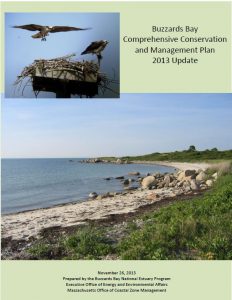2013 CCMP, Action Plan 7:
Protecting and Restoring Wetlands
About the new Buzzards Bay CCMP Action Plans
The Buzzards Bay Comprehensive Conservation and Management Plan (CCMP) was updated in November 2013 to reflect the great progress achieved since the original CCMP was finalized. You can download the entire document (buzzards-bay-ccmp-2013-update.pdf) or just this action plan Protecting Wetlands.
Protecting and Restoring Wetlands
Problem
Marine and freshwater wetlands continue to be lost and degraded. Although the rate of loss has diminished greatly in recent years, reductions in future wetland losses and wetland habitat degradation will only be achieved through increased local training and enforcement, education of property owners, and the adoption of local wet-land regulations to address shortcomings of state and federal laws.
The management of stormwater discharges has become an increased responsibility of conservation commissions. These stormwater treatment requirements must be strengthened to better achieve water quality goals (like open shellfish beds), and conservation commissions need to better coordinate with other boards to ensure comprehensive and consistent town-wide stormwater management requirements.
Additional efforts are needed to restore existing de-graded wetlands and remedy past wetland violations. This requires a more robust enforcement approach and additional public funding for restoration projects. This action plan principally relates to the enforcement of existing laws and regulations, and the need to adopt municipal laws and regulations that address local needs and conditions. Additional issues relating to wetlands protection and restoration can be found in many other action plans in this Buzzards Bay CCMP
Goal
Long-term increase of high-quality wetlands in Buzzards Bay and its surrounding watershed.
Objectives
Objective 7.1. To protect existing wetlands.
Objective 7.2. To encourage restoration of degraded wetlands.
Objective 7.3. To improve enforcement of wetlands laws.
Objective 7.4. To upgrade the effectiveness of local conservation commissions to protect wetlands.
Objective 7.5. To create new wetlands habitat, especially habitat that can be used by threatened, rare and endangered coastal species and anadromous and catadromous fish.
Approaches
Most of the action needed to achieve the goals of this action plan relate to improved enforcement of existing regulations, or the need to adopt municipal laws and regulations that supplement the minimum standards im-posed by state and federal laws. Improved enforcement, monitoring wetland loss using aerial photography, and implementation of new local wetlands laws and regulations are the key actions. Continued training of municipal staff (conservation agents) and municipal conserva-tion commission members will facilitate these actions. Wetlands regulations are among the most complex that are enforced locally, and there is a steep learning curve for municipal officials in their successful implementation. Because local conservation commissioners are vol-unteer appointees with little training in wetland science, it is important that state and regional agencies (like the Buzzards Bay NEP) provide training and support.
The two most challenging aspects of enforcing wetlands regulations are the accurate delineation of wetland boundaries, and the adequacy of stormwater treatment designs (which has a primary benefit to water quality). Municipal boards must carefully review these elements for accuracy and adequateness. These can be assured through improved training of commissioners and staff, utilization of free technical services (like the Buzzards Bay NEP), and for complex projects, hiring consultants, paid for by the applicant, as provided under state laws.
Municipalities can reduce future threats to wetlands by promoting open space acquisition and conservation restrictions on lands with appreciable wetland habitat, and by helping restore filled or impaired wetlands.
Costs and Financing
The cost of adoption of regulations is negligible to government, but the staff to implement and enforce additional regulations is an added cost. Most of the training courses are available at no or little cost. Other needed actions, like the restoration of wetlands, or the permanent protection of wetlands and habitat will only be achieved through additional government funding. For example, a funding level of $1 million per year could leverage the protection or restoration of many hundreds of acres annually.
Measuring Success
Most of the elements of this action plan can be addressed through tracking programmatic actions, like the adoption or update of bylaws and regulations. Some actions, like numbers of acres lost, restored, or protected are useful metrics, and are already being tracked by DEP or the Buzzards Bay NEP.
Additional Background
For goals and objectives related to wetland protection and restoration, also refer to Action Plan 8. Restoring Migratory Fish Passageways, Action Plan 9. Protecting Bio-Diversity and Rare and Endangered Species Habitat, Action Plan 10. Managing Water Withdrawals to Protect Wetlands, Habitat, and Water Supplies, Action Plan 12. Protecting Open Space and Action Plan 13. Protecting Ponds and Streamsaction plans have many goals, objectives, and suggested actions that compliment this action plan.
